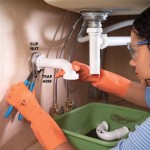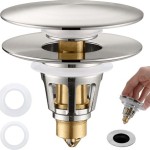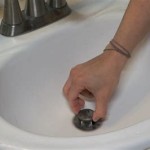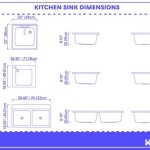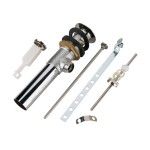Water Not Draining From Sink But No Blockage
A slow-draining or completely stagnant sink can be a frustrating plumbing issue. While a blockage is the most common culprit, sometimes water fails to drain despite the absence of any apparent obstruction. This perplexing situation can stem from several less obvious causes, requiring a more nuanced troubleshooting approach.
One potential issue lies within the sink's P-trap. While a clog within the trap itself is easily addressed, a partial blockage further down the drain line can create a vacuum effect in the P-trap. This vacuum prevents water from flowing freely through the trap, mimicking a full blockage. To check for this, a drain snake can be inserted past the P-trap to investigate the drain line for partial obstructions.
Another frequently overlooked factor is the vent system. Plumbing vents allow air to enter the drain system, equalizing pressure and enabling smooth water flow. A blocked vent pipe can disrupt this pressure balance, creating a vacuum that hinders drainage. Vent blockages can arise from various sources, including debris, nests from birds or rodents, or even ice in colder climates. Inspecting and clearing the vent pipe, often located on the roof, can resolve this issue. This task may require professional assistance.
Issues with the main drain line can also manifest as slow drainage in individual sinks. While a complete blockage in the main line would likely affect all plumbing fixtures in the house, a partial blockage can initially impact only certain fixtures, particularly those furthest from the main sewer connection. Diagnosing a main drain issue typically requires professional plumbing expertise and specialized equipment, such as a drain camera.
Improperly installed or sized drain pipes can contribute to drainage problems. If the pipes are too narrow or have insufficient slope, water flow can be restricted, leading to slow drainage. Similarly, sharp bends or kinks in the drain pipes can impede water flow. Addressing these issues often involves replacing sections of the drain line with appropriately sized and configured pipes, a task best handled by a qualified plumber.
Mineral buildup can also contribute to slow drainage. Over time, minerals dissolved in water can accumulate on the interior surfaces of drain pipes, effectively narrowing the passage and restricting water flow. This is more common in areas with hard water. Chemical drain cleaners designed to dissolve mineral deposits can sometimes alleviate this issue, but severe buildup may require more aggressive methods, such as professional drain cleaning.
A less common but potential cause is a faulty sink stopper. If the stopper mechanism is not fully opening or is malfunctioning, it can restrict water flow. Inspecting and cleaning the stopper mechanism, or replacing it if necessary, can resolve this problem.
Frozen drain pipes can also lead to complete drainage blockage, particularly in colder climates. If the pipes are frozen, attempting to thaw them with boiling water or a hairdryer can sometimes resolve the issue. However, caution should be exercised to avoid scalding or fire hazards. If the frozen section is inaccessible or the problem persists, professional plumbing assistance is recommended.
Investigating drainage issues requires a systematic approach. Start by examining the simplest and most accessible components, such as the P-trap and stopper. If these are clear, move on to more complex possibilities, such as vent blockages or main drain issues. While some of these issues can be addressed with DIY methods, others require specialized tools and expertise. Knowing when to call a professional plumber can prevent further damage and ensure the issue is resolved effectively.
Regular maintenance can help prevent many drainage issues. Periodically flushing the drains with hot water can help prevent grease and soap buildup. Avoid pouring grease down the drain, and use strainers to catch hair and other debris. Regularly inspecting and cleaning the P-trap can also prevent blockages. By taking these preventative measures, homeowners can minimize the risk of encountering slow or stagnant sink drains.
Understanding the various factors that can contribute to drainage problems, even in the absence of a visible blockage, empowers homeowners to troubleshoot effectively and make informed decisions about seeking professional help when necessary. A methodical approach to investigating the problem, coupled with preventative maintenance, can keep drains flowing freely and prevent frustrating plumbing issues.

Slow Sink Drain Kitchen Not The Trap

What Do You When Your Kitchen Sink Won T Drain

How You Can Fix A Slow Draining Drain On Your Own Call Ashton Plumbing

How To Fix A Bathroom Sink That Won T Drain Bfp Bay Area

How To Unclog A Kitchen Sink Youtube

What Do You When Your Kitchen Sink Won T Drain

How To Unclog A Bathroom Sink Hana S Happy Home

9 Blocked Sink Waste Problems Cures Q A

10 Tips For Unblocking Any Drain Diy Professional

How To Unclog A Sink The Right Way
